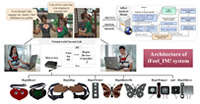Research highlights
Affective Haptics: Emotional real-time messaging
Affective haptics refers to research on the implementation of devices and systems for enhancing the emotional state of a person via the sense of touch. The research field was created by Dzmitry Tsetserukou and Alena Neviarouskaya.
Here, Dzmitry Tsetserukou of the Electronics-Inspired Interdisciplinary Research Institute (EIIRIS) in collaboration with Alena Neviarouskaya at The University of Tokyo, designed iFeel_IM! to intensify the communicators' own feelings or simulate the partner's emotions in order to enhance social interactivity and provide an emotionally immersive experience for real-time messaging. (Fig. 1). The philosophy behind iFeel_IM! is "I feel [therefore] I am!"
Interpersonal relationships and the ability to express empathy are stronger when people become emotionally closer by disclosing thoughts, feelings, and emotions for the sake of understanding. iFeel_IM! tries to influence human emotions not only by the four haptic channels but also by visual feedback.
- iFeel_IM! stresses
- automatic sensing of emotions conveyed through text messages, namely artificial intelligence
- visualization of the detected emotions through avatars in a virtual world
- enhancement of the user's affective state
- reproduction of social touch through haptic stimulation in the real world
- To support affective communication, iFeel_IM! incorporates three types of haptic devices (Fig. 2):
- HaptiHeart, HaptiButterfly, HaptiTemper, and HaptiShiver implicitly elicit emotion
- HaptiTickler directly evokes emotion
- HaptiHug uses social touch to influence mood and provide a sense of physical co-presence
The researchers have exhibited iFeel_IM! at international conferences such as as Intetain 2009, ACII 2009, Asiagraph 2009, CHI 2010 and more than 400 people have experienced it. Most participants reported that the haptic modalities (the simulated heartbeats, hugging, and tickling) produced highly realistic sensations. The subjects particularly enjoyed wearing HaptiHug—the simultaneous experience of the hugging animation and hugging sensation evoked surprise and joy. The results of user studies revealed that the devices successfully generated the corresponding emotion.
The researchers' iFeel_IM! Demonstrations resulted in keen discussions of possible applications for future research. Examples include
- treating depression and anxiety (problematic emotional states)
- controlling and modulating moods on the basis of physiological signals
- affective and collaborative games
- psychological testing
The iFeel_IM! could greatly enhance communication in online virtual environments that facilitate social contact. It could also greatly enhance social life in terms of both interpersonal relationships and the character of communities.
- Reference:
- D. Tsetserukou1 and A. Neviarouskaya2
- iFeel_IM!: augmenting emotions during online communication.
- IEEE Computer Graphics ad Applications 30, 72 (2010)
- DOI: 10.1109/MCG.2010.88
- 1Electronics-Inspired Interdisciplinary Research Institute (EIIRIS), Toyohashi University of Technology;
2 University of Tokyo
- Further information
- Electronics-Inspired Interdisciplinary Research Institute (EIIRIS):
http://www.eiiris.tut.ac.jp/ - Video websites:
https://www.youtube.com/watch?v=Y84XbpDUVxc
https://sites.google.com/site/dzmitrytsetserukou/media-press/ifeel_im
http://en.wikipedia.org/wiki/Affective_Haptics
http://watch.discoverychannel.ca/clip287052#clip287052

Dr . Tsetserukou

Fig.1. A user communicating through iFeel_IM! (Intelligent System for Feeling Enhancement Powered by Affect-Sensitive Instant Messenger). The devices worn on the body reinforce the communicators' own feelings or simulate the partner's emotions.

Enlarge Image
Figure 2. The iFeel_IM! architecture. To communicate through iFeel_IM!, users wear six affective haptic devices: HaptiHeart, HaptiHug, HaptiButterfly, HaptiTickler, HaptiTemper, and HaptiShiver.


